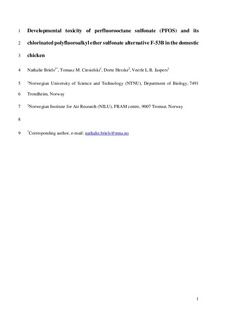| dc.contributor.author | Briels, Nathalie | |
| dc.contributor.author | Ciesielski, Tomasz Maciej | |
| dc.contributor.author | Herzke, Dorte | |
| dc.contributor.author | Jaspers, Veerle | |
| dc.date.accessioned | 2019-04-23T07:55:20Z | |
| dc.date.available | 2019-04-23T07:55:20Z | |
| dc.date.created | 2018-11-20T12:44:57Z | |
| dc.date.issued | 2018 | |
| dc.identifier.citation | Environmental Science and Technology. 2018, 52 (21), 12859-12867. | nb_NO |
| dc.identifier.issn | 0013-936X | |
| dc.identifier.uri | http://hdl.handle.net/11250/2594967 | |
| dc.description.abstract | The chlorinated polyfluoroalkyl ether sulfonate F-53B is used as a mist suppressant in the Chinese electroplating industry. Because of the regulations on perfluorooctanesulfonate (PFOS), its use is expected to increase. Until now, F-53B toxicity data have been scarce and are, to our knowledge, lacking for birds. This study therefore investigated the effects of PFOS and F-53B, separately and as mixtures, on the development of the chicken (Gallus gallus domesticus). Compounds were injected in ovo, before incubation, at 150 and 1500 ng/g egg. At embryonic day 20, a significantly lower heart rate was observed in all treated groups compared to the control group and hatchlings exposed to the high dose of F-53B had a significantly enlarged liver (8%). Embryonic survival was not affected and no significant effects on hatchling body mass or oxidative stress parameters were found. Our results suggest that these compounds likely have different toxicity thresholds for the investigated endpoints, and/or different modes of action. This study thereby underlines the potential developmental toxicity of PFOS and F-53B at environmentally relevant concentrations. Assessment of PFOS alternatives should therefore continue, preferably prior to their large scale use, as they should be ensured to be less harmful than PFOS itself. | nb_NO |
| dc.language.iso | eng | nb_NO |
| dc.publisher | American Chemical Society | nb_NO |
| dc.title | Developmental toxicity of perfluorooctanesulfonate (PFOS) and its chlorinated polyfluoroalkyl ether sulfonate alternative F-53B in the domestic chicken | nb_NO |
| dc.type | Journal article | nb_NO |
| dc.type | Peer reviewed | nb_NO |
| dc.description.version | acceptedVersion | nb_NO |
| dc.source.pagenumber | 12859-12867 | nb_NO |
| dc.source.volume | 52 | nb_NO |
| dc.source.journal | Environmental Science and Technology | nb_NO |
| dc.source.issue | 21 | nb_NO |
| dc.identifier.doi | 10.1021/acs.est.8b04749 | |
| dc.identifier.cristin | 1632605 | |
| dc.relation.project | Norges forskningsråd: 230465 | nb_NO |
| dc.relation.project | NILU - Norsk institutt for luftforskning: 114050 | nb_NO |
| dc.description.localcode | © American Chemical Society 2018. This is the authors accepted and refereed manuscript to the article. Locked until 10.10.2019 due to copyright restrictions. | nb_NO |
| cristin.unitcode | 194,66,10,0 | |
| cristin.unitname | Institutt for biologi | |
| cristin.ispublished | true | |
| cristin.fulltext | postprint | |
| cristin.qualitycode | 2 | |
